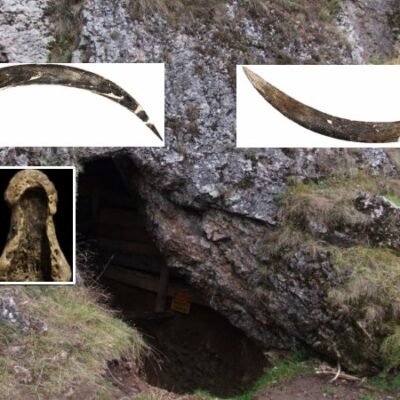Conny Waters – AncientPages.com – During archaeological excavations at the Chalcolithic site of Valencina de la Concepción in Seville, Spain, scientists made several intriguing discoveries that prompted a re-evaluation of their previous theories about this ancient location. Researchers now acknowledge that the “mega-village” of Valencina de la Concepción was not as previously thought.
Credit: Ángel M. Felicísimo – CC BY-SA 2.0, Museu Nacional de Arqueologia – Public Domain, German Archaeological Institute of Madrid. Image compilation AncientPages.com
Spanning a total area of 450 hectares, it is the largest site in Europe from the third millennium B.C. Despite accumulating information on its megalithic tombs and concentric graves, knowledge about its settlement area—covering approximately 200 hectares—and the economic practices and social relations of its communities remains limited.
The Copper Age mega-village was continuously inhabited for a millennium, from 3300 to 2150 B.C., by a community numbering several thousand who organized themselves in an egalitarian fashion and achieved significant economic sustainability through cooperation and diversification.
A research team from Universitat Autònoma de Barcelona (UAB) analyzed 635 macrolithic tools recovered from the site’s northern part. The study’s findings reveal that Valencina de la Concepción was a complex and enduring settlement rather than merely a ritual or temporary gathering place as previously assumed. This analysis allowed researchers to gain insights into the economic activities conducted throughout the settlement’s occupation and to reassess its socio-economic organization.
The total excavated area included in this project comprises nearly 1560 m2. Credit: Journal of Archaeological Science (2025) DOI: 10.1016/j.jas.2025.106234
The artifacts examined originated from habitation and production units, such as huts, workshops, and circularly arranged pits, as well as materials found within ditches. The analysis indicates an economy based on domestic and subsistence activities with considerable productive diversity—including processing grains, plant fibers, animals, leather, metals, stone, alongside other organic and inorganic materials—maintained consistently throughout its entire occupation during the Copper Age between 5,300 and 4,150 years ago.
Marina Eguíluz, a predoctoral researcher at the Department of Prehistory of the UAB and lead author of the study, highlights that “this indicates a permanent occupation of the settlement.” The only noticeable changes across the three main phases appear to be related to the density of population in the area. The diverse range of work identified, coupled with the absence of surplus accumulation, strongly suggests an organizational model rooted in cooperation and economic diversification.
This productive approach, alongside a fundamentally egalitarian structure, would have enabled a population—likely numbering several thousand—to maintain economic sustainability over an entire millennium. This compelling evidence underscores how such models can effectively support large communities over extended periods.
“The observed continuity highlights the sustainability of the socioeconomic model present during the Copper Age, based on cooperativism and the lack of accumulation and centralisation, and differentiated from later models of productive intensification.
Grinding slab damaged by fire found at the site. Credit: Journal of Archaeological Science (2025) DOI: 10.1016/j.jas.2025.106234
This reinforces the proposal to define the most developed communities of the Copper Age in the south of the Iberian Peninsula as cooperative societies of abundance, a form of social organisation that deeply questions the traditional evolutionary models, based on hierarchical and power relations between bands, tribes, prefectures or states”, emphasises Roberto Risch, researcher of Prehistory at the UAB and coordinator of the study.
Until now, research on Valencina de la Concepción has primarily concentrated on its necropolis and specific sections of the settlement. The focus has been on objects linked to funerary practices, items from distant origins, and specialized crafts such as pottery, metallurgy, and copper production. Stone materials were previously seen as ritualistic due to their fragmented nature and thus received limited attention regarding their role in subsistence and daily activities.
The artefacts examined in this study were excavated from Cerro de la Cabeza and the Pabellón Cubierto as part of the Valencina Nord project. This initiative was developed by the German Archaeological Institute of Madrid, the University of Würzburg, and the Autonomous University of Madrid, with collaboration from UAB.
The study reveals that these tools were extensively used and often repurposed. The materials for these tools were sourced within a 30-kilometre radius, indicating local and regional management of lithic resources.
See also: More Archaeology News
The methodology involved a technological and functional analysis of artifacts alongside macroscopic identification of raw materials to explore aspects such as origin, production processes, usage patterns, disposal methods, radiocarbon dating results, and stratigraphic observations. Additionally, some items contained organic samples that have enhanced our understanding of their functions.
The study conducted by UAB researchers presents a compelling opportunity to embark on new comparative studies with other Chalcolithic sites, specifically focusing on macrolithic artifacts.
The study was published in the Journal of Archaeological Science: Reports
Written by Conny Waters – AncientPages.com Staff Writer








